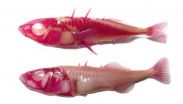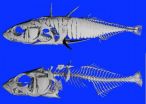(Press-News.org) Sticklebacks, the roaches of the fish world, are the ideal animal in which to study the genes that control body shape. They've moved from the ocean into tens of thousands of freshwater streams and lakes around the world, each time changing their skeleton to adapt to the new environment.
Breeding studies between marine and freshwater populations of sticklebacks now have turned up one of the genes that controls tooth number, plus evidence that a simple change in that gene's regulation in a freshwater population is associated with a near doubling in the number of teeth. University of California, Berkeley, scientists say that the corresponding gene in humans may turn out to be involved in tooth, jaw and bone formation.
"This study suggests that the gene, called Bmp6, plays a key role in regeneration of vertebrate organs," said lead researcher Craig Miller, UC Berkeley assistant professor of molecular and cell biology. "Understanding tooth regeneration could lead to a way to replace teeth in humans, for example."
"It's also clear that there is some biological connection between tooth number and cleft palate, because the same regions of the genome control both," he added. "Understanding which genes control the number of teeth is important for understanding what causes malformations, such as a cleft palate."
Miller and his UC Berkeley and Stanford University colleagues reported their findings in last week's issue of the journal Proceedings of the National Academy of Sciences.
The finding has implications, too, for how evolution generates new body shapes. Biologists have proposed that this results primarily from changes in the regulation of a functional gene, not mutations in the gene itself. To date, this has proved true for loss of traits in fish: armor plates, pelvic fins and pigment.
"This is one of the first cases where we find that the rules found for traits lost apply as well to traits gained," said Miller.
Rapid adaptation to fresh water
Like salmon, the two-inch long, threespine stickleback (Gasterosteus aculeatus) is anadromous: it lives in oceans, but swims up freshwater streams to breed. Since the end of the last Ice Age 12,000 years ago, many sticklebacks have colonized lakes and creeks, where their bodies quickly adapted to the new environment: they developed more teeth and stronger jaws, presumably to crack open larger prey found in freshwater, and they lost their armor, perhaps because of fewer predators. In one Alaskan Lake, these changes took a mere 10 years.
Miller, along with his postdoctoral advisor, coauthor David Kingsley of Stanford University, and scientists at the Broad Institute at MIT, sequenced the genomes of sticklebacks from 21 populations in 2012. They and established that all sticklebacks seem to have the same genes, but that rapid change in regulatory DNA allowed them to alter expression of their genes in order to adapt quickly to changing environments.
Because the ancestral saltwater populations still can breed with freshwater populations to produce fertile offspring, researchers can crossbreed fish from different populations to track down the genes and regulatory regions responsible for these body changes. In 2007, shortly after the stickleback genome was sequenced, Miller used crossbreeding to track down genes involved in pigmentation in both fish and humans. At UC Berkeley, he maintains 171 fish tanks with sticklebacks from 11 populations around the world, ranging from Japan and Canada to the San Francisco Bay Area, where 58 of 66 streams are populated with threespine sticklebacks.
The new study pinpoints one likely gene, bone morphogenetic protein 6 (Bmp6), responsible for tooth number. While the gene seems to be identical in all sticklebacks, regulatory pieces of DNA sitting next to Bmp6 are different in marine versus freshwater fish, suggesting that altered regulation is responsible for the extra teeth. The Bmp6 gene is expressed at higher levels in freshwater fish than in ocean fish.
Goosing up genes
"We think goosing up the Bmp6 signal doubles the number of teeth," Miller said. "This fairly simple genetic basis for gaining something new, such as teeth, is surprising. A very tiny change in the regulator has a large effect."
The boost in Bmp6 activity occurs late in the development of the fish larva, when it's already nearly an inch long and halfway to adulthood. Before that time, freshwater and ocean fish have the same number of teeth. The number of teeth in freshwater sticklebacks continues to increase throughout their lifetime as the area of the tooth plate and the density of teeth both increase.
"We found that freshwater-derived sticklebacks keep making teeth constantly and never seem to slow down, whereas the ancestral form stops making more teeth," he said. "While biologists have known for a long time that sharks and some fish continually replace their teeth, almost nothing was known until now about the genetic basis of evolved changes in teeth patterning."
Miller and his colleagues located the Bmp6 gene by crossing marine sticklebacks from Alaska with freshwater sticklebacks from Paxton Lake, Canada. The Canadian fish have about twice the number of teeth as the Alaskan ocean fish. He had earlier identified seven regions of the fish genome involved in controlling tooth number. The new study narrowed down one of these to a stretch of DNA on chromosome 21, which contains the Bmp6 gene.
INFORMATION:
The research was funded in part by the National Institutes of Health. Coauthors of the paper are Phillip A. Cleves, Nicholas A. Ellis and Monica T. Jimenez of UC Berkeley; Stephanie M. Nunez and David M. Kingsley of Stanford University; and Dolph Schluter of the University of British Columbia in Vancouver, Canada.
Counting fish teeth reveals regulatory DNA changes behind rapid evolution, adaptation
Study pinpoints genes possibly involved in jaw, palate deformities
2014-09-17
ELSE PRESS RELEASES FROM THIS DATE:
Smart teens rub off on teammates
2014-09-17
A new study of high school activities bears this message for incoming high school students: Play what the smart kids play.
Joining an extra-curricular team or club with members that get good grades can double a high school student's odds of going to college.
And Brigham Young University sociologist and study co-author Lance Erickson knows how to sell the study to teens.
"Tell your parents, whatever they ground you from, it shouldn't be from practice or a club activity," said Erickson. "If they ground you from a school club, you are more likely to end up living at ...
Being social: Learning from the behavior of birds
2014-09-17
VIDEO:
In this Science Minute from NIMBioS, Dr. Elizabeth Hobson explains what monk parakeets can teach us about complex sociality.
Click here for more information.
KNOXVILLE—Science has learned a great deal about complex social behavior by studying nonhuman mammals and primates, but parrots might have something to teach too.
With their unusually large brains relative to their body size and advanced cognition, parrots live in a complex social environment---not merely in ...
Malaysia's 'Smart Villages' and 9 other proven ideas for sustainable development
2014-09-17
As nations zero in on the UN's post-2015 global Sustainable Development Goals, innovations being successfully pioneered and demonstrated in Malaysia offer several proven tactical ideas for improving the world, says an influential international sustainable development networking organization.
The UN's Sustainable Development Solutions Network (SDSN), through its Malaysian chapter, cites ways in which the country is "rising to the challenge," including the construction of ingenious, self-sustaining "smart" villages -- each lifting about 100 families out of poverty and ...
New study examines the impact of socioeconomic position and maternal morbidity in Australia
2014-09-17
The risk of severe maternal morbidity amongst women in Australia is increased by lower socioeconomic position, suggests a new study published today (17 September) in BJOG: An International Journal of Obstetrics and Gynaecology.
Australians generally enjoy high standards of living; however, existing research has concluded that health disparities exist, in particular between indigenous and non indigenous Australians.
This case-control study aimed to explore the independent impact of socioeconomic position on severe maternal morbidities associated with direct maternal ...
Global change: Trees continue to grow at a faster rate
2014-09-17
Trees have been growing significantly faster since the 1960s. The typical development phases of trees and stands have barely changed, but they have accelerated -- by as much as 70 percent. This was the outcome of a study carried out by scientists from Technische Universität München based on long-term data from experimental forest plots that have been continuously observed since 1870. Their findings were published recently in Nature Communications.
Three decades ago, "forest dieback" was a hot topic, with the very survival of large forest ecosystems seemingly in doubt. ...
Nanoscience makes your wine better
2014-09-17
One sip of a perfectly poured glass of wine leads to an explosion of flavours in your mouth. Researchers at Aarhus University, Denmark, have now developed a nanosensor that can mimic what happens in your mouth when you drink wine. The sensor measures how you experience the sensation of dryness in the wine.
When wine growers turn their grapes into wine, they need to control a number of processes to bring out the desired flavour in the product that ends up in the wine bottle. An important part of the taste is known in wine terminology as astringency, and it is characteristic ...
The mobility model is closely linked to the city's characteristics
2014-09-17
This news release is available in Spanish and Spanish.
As far as the conclusions of the study are concerned, the following aspects, among others, are worth highlighting: the more compact the town or city is, the more concentrated is its population; the more jobs there are in the municipality itself, etc., the less private vehicles are used; the better the offer of public transport, the lower the number of people who use private cars; the higher the per capita income is (in small localities), the greater is the tendency to use the private car. According to Mendiola, ...
Magnetic resonance helps to detect and quantify fat in liver
2014-09-17
This news release is available in Spanish.
Obesity and overweight affect more than half of the population in our Community. Excess weight causes important alterations in the organism, one of which affects liver function. Fat accumulates in the liver producing hepatic steatosis which, in certain circumstances, causes inflammation, fibrosis and finally, cirrhosis. To date, the most reliable method for determining hepatic fat has been hepatic biopsy. Imaging techniques such as abdominal ecography detect it but are less precise for determining the quantity of fat.
But ...
Car hacking: The security threat facing our vehicles
2014-09-17
The car of the future will be safer, smarter and offer greater high-tech gadgets, but be warned without improved security the risk of car hacking is real, according to a QUT road safety expert.
Professor Andry Rakotonirainy will speak at the Occupational Safety in Transport Conference (OSIT) on the Gold Coast on September 18-19 on the security threat facing drivers as vehicles become computers on wheels.
Professor Rakotonirainy, from QUT's Centre for Accident Research & Road Safety - Queensland (CARRS), has researched the security systems of existing fleet, future ...
Survey finds benefits, risks of yoga for bipolar disorder
2014-09-17
PROVIDENCE, R.I. [Brown University] — Right now no one can say whether yoga provides clinical benefits to people with bipolar disorder, but in a new article in the Journal of Psychiatric Practice, researchers report survey responses they gathered from scores of people with the condition who practice yoga. What the collective testimony suggests is that yoga can be a substantial help, but it sometimes carries risks, too.
"There is no scientific literature on hatha yoga for bipolar disorder," said lead author Lisa Uebelacker, associate professor (research) of psychiatry ...
LAST 30 PRESS RELEASES:
New modeling approach sheds light on rare gut disease
Study documents potentially hazardous flame retardants in firefighter gear
Can certain bacteria regulate aging of the immune system and its related alterations?
AI model helps diagnose often undetected heart disease from simple EKG
There are fewer online trolls than people think
Cell membrane fluctuations produce electricity
Jeonbuk National University study shows positive parenting can protect adolescents against self-harm
Surface-engineered ZnO nanocrystals to tackle perfluoroalkyl substance contamination
This new understanding of T cell receptors may improve cancer immunotherapies
A new fossil face sheds light on early migrations of ancient human ancestor
A new immunotherapy approach could work for many types of cancer
A new way to diagnose deadly lung infections and save lives
40 percent of MRI signals do not correspond to actual brain activity
How brain-inspired algorithms could drive down AI energy costs
Gum disease may be linked to plaque buildup in arteries, higher risk of major CVD events
Contrails are a major driver of aviation’s climate impact
Structure of dopamine-releasing neurons relates to the type of circuits they form for smell-processing
Reducing social isolation protects the brain in later life
Keeping the heart healthy increases longevity even after cancer
Young adults commonly mix cannabis with nicotine and tobacco
Comprehensive review illuminates tau protein's dual nature in brain health, disease, and emerging psychiatric connections
Book prepares K-12 leaders for the next public health crisis
Storms in the Southern Ocean mitigates global warming
Seals on the move: Research reveals key data for offshore development and international ecology
Sports injuries sustained during your period might be more severe
World's first successful 2 Tbit/s free-space optical communication using small optical terminals mountable on satellites and HAPS
Can intimate relationships affect your heart? New study says ‘yes’
Scalable and healable gradient textiles for multi‑scenario radiative cooling via bicomponent blow spinning
Research shows informed traders never let a good climate crisis go to waste
Intelligent XGBoost framework enhances asphalt pavement skid resistance assessment
[Press-News.org] Counting fish teeth reveals regulatory DNA changes behind rapid evolution, adaptationStudy pinpoints genes possibly involved in jaw, palate deformities








